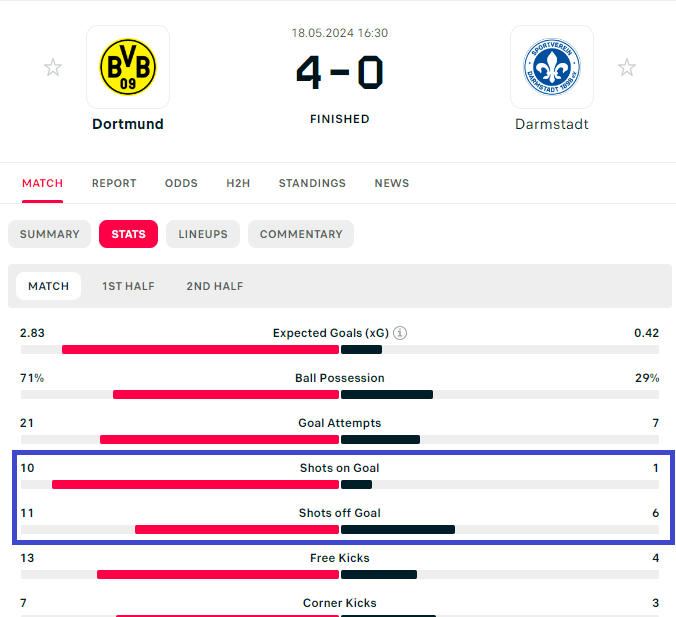In this article, I will show you how to analyze team form and performance metrics for placing better wagers. From goals scored and conceded to possession, shots on target, and expected goals, I will guide you on interpreting all this data to make better betting decisions.
The development of new technologies in sports skyrocketed in the last decade. While previously you had limited data about a team’s performance metrics, now you can accurately know how many miles a team has run during the entire game, how many goals were scored from outside the box, and many more. Furthermore, with data sensors fitted on players, the sports performance department can accurately present valuable data to the manager about each player’s strong points and what he needs to improve.
Team form and goals metrics
Breaking down the goals scored and conceded by a team during an entire season points out the attacking prowess and defensive weakness, information you can use when setting up a long-term betting strategy. For example, using D’Alembert to back Liverpool at Anfield in the Premier League to score over 2.5 goals or to net in both halves based on previous years’ team form and performance metrics. A quick look at the Mersey side team indicates Liverpool averaged 2.58 goals scored per game at Anfield in the 2023-2024 season.
Goals scored
With the latest technology available in football to analyze performance metrics, the bookies adapted their offer giving punters diverse options to back a player to score. Some of these are:
- to score with a header
- to score with a shot
- to score outside the box
- to score from the penalty spot
While choosing a goalscorer in the match is considered a safer option, predicting how the goal will be scored boosts significantly higher odds. Let’s take as an example the new Premier League sensation, Cole Palmer. By breaking down his goals scored metrics we notice the Chelsea ace scored 73% of his goals from inside the box with a shot. You can use this data during the season to place specific wagers based on accurate metrics that yield a potentially higher return.
Goals conceded
Keeping the same competition, Sheffield United has set up an unwanted record by conceding 104 goals in 38 Premier League games. The Blades failed to adapt to the fast-paced football in the Premier League early on by suffering 9 defeats in the first 10 rounds.
Also, conceding 8 goals against Newcastle and 5 against Arsenal during this period indicated that the Blades would be the perfect opponent to improve a team’s goal difference. Furthermore, you could benefit from this data and back Sheffield United opponents to win comfortably using the Asian Handicap market.
Betting markets influenced by possession
Possession is a metric used in football to determine how dominant a team is during a match. Top teams like Manchester City, Real Madrid, PSG and Inter will have the ball most of the game. While this is a well-known fact, you can use this data to your advantage by placing wagers on corners.
Last season’s PSG games had an average of 10 corner kicks per match with the Ligue 1 giants dominating their opponents but leaving spaces on the break. Although betting on corners is considered a more volatile market because luck also plays a part in the outcome, you can set up a season-long betting strategy with a great potential return.
Furthermore, many bookies offer a special market based on possession in which you can predict how much a team will have the ball using interval percentages (ex: 60-70%). Also, possession directly influences other metrics such as shots, goals scored, assists and the distance run by a specific player or the whole team.
A well-established fact is that you run much more out of possession (defending) than when in possession (attacking).
How to analyze shots on target performance metrics
Shots on target indicate the accuracy of a team in front of the opposition goal and the clear chances created to score. A simple formula calculates this metric by dividing the number of shots on target by the total number of shots taken. The result is multiplied by 100 and expressed as a percentage.
Notice Borussia Dormtund’s clear dominance of Darmstadt that resulted in 21 total shots from which 10 were on target. Referring to the previous formula, the shots on target percentage calculation is:
(10/21)*100 = 47,61%
Furthermore, Dortmund’s accuracy was good scoring 4 goals from 10 shots on target. Also, notice how der BvB’ possession influenced their number of corners (7).
What is the expected goals metric in football?
Expected goals (xG) is one of the most used metrics to predict a team or players’ expected goals scored or conceded. Some factors that influence the xG are the number of shots, the distance and the field position. For example, a shot from close range inside the box from the centre position will have a much higher xG than a 30-yard strike close to the touchline. Also, looking at the above screenshot you can see Dortmund were very effective scoring 4 goals while having a 2.83 xG factor.
Other types of performance metrics used in football
Although I described how to analyze team form and performance metrics using the most common ways, the technology can provide a manager with further details about his players and team’s performance using other detailed metrics. Some of these are:
- Field Tilt measures the territorial dominance of a team in a specific part of the pitch
- Goal Conversion shows a team’s capacity to convert their chances created (measured in percentage)
- Expected Assists (XA) shows the ability of a player to create chances on the pitch that will put his teammates in a great position to score
- Shooting Goals Added (SGA) measures the efficiency of a player to score from a low-quality chance
- Expected Threat (XT) measures a player’s offensive game by looking at his quality dribbling and passes
Understanding better how to analyze team form and performance metrics allows you to place in-play wagers, ACCAs or other types of bets more confidently. Gamble responsibly using the money you can afford to lose.
- Soccer News Like
- Be the first of your friends!




















